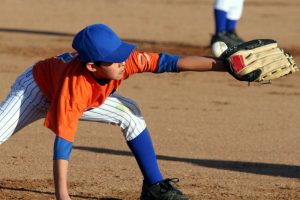What Are Common Dental Emergencies for Athletes?
May 4, 2022

Stats are a big part of many sports, and the statistics point to the fact that athletes should be wearing mouthguards. After all, almost 50 percent of all dental injuries are sports-related. Athletes are among the people at greatest risk of facing a dental emergency. About 10 percent of players on a team will incur a dental or facial injury in an average season. Decades ago, it may have been viewed as inevitable, but these days people are more aware of the serious long-term health issues that can arise due to oral injuries. Keep reading to learn common examples of what can happen while playing sports from your emergency dentist in Tyler, as well as how you can prevent them.
Cracked Teeth
Always be careful when participating in sports that involve balls, bats, or physical contact. One blow to the face could easily result in a cracked or fractured tooth. If the tooth shows cracks that appear across it, they’re called “craze lines” and don’t necessarily pose a threat to your oral health.
However, if the crack begins at the tooth’s chewing surface and extends downward, it’s considered a cracked tooth. With that, you might experience the following:
- Sharp pain when biting down
- Recurring tooth pain
- Pain while eating and drinking (particularly when consuming hot or cold foods and drinks)
Since a cracked tooth isn’t always noticeable, you might not realize you have one until your dentist discovers it during a checkup.
Tooth Intrusion
Rather than knocking a tooth out, some sports injuries can drive a tooth back into the jawbone. This type of injury is referred to as an intrusion and is usually more common in baby teeth. However, it can happen to athletes of all ages! Tooth intrusion can lead to other complications, including the destruction of the tooth pulp, root resorption (shortening of the roots), and ankylosis (fusion of the injured tooth’s root to the alveolar bone).
Fractured Roots
If you sustain a blow at a certain angle, it could cause a fractured root. In these instances, a crack begins at the root level and extends upward to the tooth’s crown. Because fractured roots are often invisible, athletes only realize they have one when an infection develops. Patients may need root canal therapy to prevent the infection from spreading to the pulp – otherwise, it could lead to tooth loss.
Preventive Measures Athletes Can Take Against Dental Emergencies
You must take all necessary precautions as an athlete to keep your mouth safe. Here are two ways you can protect your teeth while playing:
- Wear a mouthguard. It’s a necessity when playing any sport that involves bats, balls, sticks, or physical contact. Mouthguards are custom-fitted, bracing your teeth against impact.
- Wear a helmet. If you want an added layer of protection, consider wearing a sturdy helmet with a faceguard. It’ll protect your head and mouth against injury!
Even though modern dentistry can repair most of these sports-related injuries, they can still take a toll on your oral health. So, before playing your favorite sport, be sure to take all protective measures necessary to keep your smile safe from a dental emergency!
About the Author
Dr. Travis Markle has been working for the smiles of patients in Tyler at Southern Oaks Dental since 2006. He earned his dental doctorate from the University of Texas Health Science Center in San Antonio. He is a member of the American Dental Association and has earned a fellowship in the Academy of General Dentistry. If you or your child ever faces a dental emergency, he offers same-day appointments and sedation dentistry. Dr. Markle can also provide custom-fitted athletic mouthguards. Schedule an appointment on his website, but if it’s an emergency, call (903) 597-7902.
No Comments »
No comments yet.
RSS feed for comments on this post. TrackBack URL
